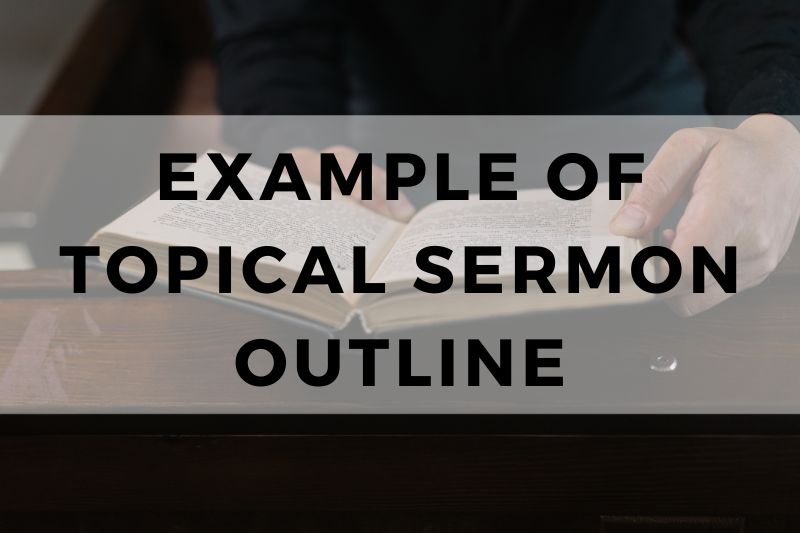
Preaching is an essential part of church life, and a well-structured sermon can deeply impact your congregation. One effective way to organize a sermon is through a topical sermon outline. This method focuses on a specific theme or topic and breaks it down into clear sections.
It helps the preacher stay focused and ensures the message is easy to follow. By using this format, you can present biblical truths in a way that is both relevant and practical. In this article, we’ll explore an example of a topical sermon outline to guide you in your preaching.
An Example of a Topical Sermon Outline for Effective Preaching
#1. Title
A clear, engaging title is crucial for setting the tone and focus of your sermon. It should reflect the main theme and provide a snapshot of what the congregation can expect. The title should be simple but thought-provoking. An effective title grabs attention and makes people want to listen. The title should also give a hint about the message’s relevance. Avoid titles that are too vague or complicated. For example, “The Power of Forgiveness in the Christian Life” directly tells the audience that the sermon will explore forgiveness and its role in the Christian walk.
#2. Introduction
The introduction is the first chance to engage your audience and set the stage. It’s important to start with something that draws the congregation in and prepares them for the rest of the message. This could be a personal story, a thought-provoking question, or a well-chosen quote that ties into the theme. The introduction should establish why the topic matters to the listeners and why it’s worth their time to pay attention. A good introduction helps the congregation connect with the sermon on a personal level. It explains the importance of the topic and makes it relevant to their lives. By the end of the introduction, the congregation should have a clear understanding of the sermon’s direction and purpose.
#3. Main Points
The sermon should be divided into three to five main points that help break down the topic. These points should cover all key aspects of the subject and be backed by scripture and examples. The main points provide structure and help the preacher stay on track. Each point should build on the previous one, guiding the congregation through the topic in a logical progression. For example, in a sermon on forgiveness:
- The Need for Forgiveness (Scripture: Matthew 6:14-15) – This point explains why forgiveness is necessary in the Christian life. It highlights the teachings of Jesus and the importance of forgiving others.
- The Process of Forgiveness (Scripture: Ephesians 4:31-32) – This point outlines how forgiveness works in practice. It covers the emotional and spiritual steps involved in letting go of resentment.
- The Rewards of Forgiveness (Scripture: Luke 6:37-38) – This point discusses the blessings that come from forgiving others, including peace and freedom.
#4. Subpoints (Optional)
Subpoints offer further breakdowns of the main points. These can provide additional clarity or examples to help the congregation understand the message more deeply. While not always necessary, subpoints can be a valuable tool for emphasizing important details or practical applications.
For instance, under the main point “The Process of Forgiveness,” you might have the following subpoints:
- Acknowledge the hurt – Recognizing and confronting the pain is the first step to healing.
- Choose to forgive – Forgiveness is a decision, not just an emotion. It’s an intentional choice to release bitterness.
- Rely on God’s strength – Forgiveness is difficult, and we need God’s help to truly forgive from the heart.
Subpoints help keep the sermon clear and focused, preventing it from becoming too broad or abstract.
#5. Supporting Scriptures
Supporting scriptures are essential for grounding each point in the authority of God’s Word. The Bible should be the primary source for your sermon, and relevant verses should support each main point or subpoint. By drawing from multiple books or sections of the Bible, you provide a well-rounded view of the topic. Using scripture also helps the congregation see that the sermon is not based on personal opinions or ideas, but on biblical truth. For example, in the sermon on forgiveness, you might use:
- Matthew 6:14-15 to show that forgiveness is a command from Jesus.
- Ephesians 4:31-32 to illustrate the practical steps of forgiveness.
- Luke 6:37-38 to explain the rewards and blessings that come from forgiving others.
These supporting scriptures create a solid foundation for your sermon, ensuring that it remains rooted in biblical principles.
#6. Illustrations
Illustrations help make the message relatable. They can be stories, analogies, or personal experiences that connect the theme of the sermon to everyday life. A good illustration paints a picture that helps the congregation understand and remember the message. For example, in a sermon about forgiveness, you might share a personal story of a time you struggled with forgiveness but experienced peace when you chose to let go.
Illustrations can also be drawn from history, literature, or popular culture, as long as they align with the sermon’s message. They should enhance the theme, not distract from it. A simple analogy for forgiveness might be: “Forgiveness is like a weight you carry around. When you forgive, you release that weight, and you feel free.”
#7. Application
Application is where the sermon becomes personal and practical. It’s about helping the congregation apply the message to their own lives. Each main point should have a corresponding takeaway that challenges the audience to act. For example, after discussing forgiveness, you could challenge your listeners with this application: “This week, pray for someone who has hurt you. Ask God to help you forgive them.”
Application connects the sermon to real-life situations. It moves the message from the abstract to the tangible. It’s where the rubber meets the road, and the congregation is given clear steps to apply the teaching in their daily lives.
#8. Conclusion
The conclusion wraps up the sermon and reinforces the main points. It’s a summary of the message that leaves the congregation with a lasting thought.
A good conclusion doesn’t introduce new ideas but emphasizes the key takeaways. It can include a call to action, a prayer invitation, or a challenge to reflect on the message.
For example, after preaching on forgiveness, you might end with: “As we leave today, let’s commit to living out the forgiveness that God has shown us. Remember, forgiveness brings freedom, and it is the heart of our Christian walk.”
The conclusion should inspire action and encourage reflection on how the message can transform lives.
#9. Closing Prayer
The closing prayer ties everything together. It asks God for help in applying the message and seeking His guidance. The prayer should focus on the sermon’s theme and ask for God’s strength to live out the teachings.
For a sermon on forgiveness, the closing prayer might be:
“Dear God, we thank You for the gift of forgiveness. We know that we are forgiven through Christ, and we ask for the strength to forgive others. Help us to let go of bitterness and choose the path of peace. Give us the grace to live in a way that reflects Your love. In Jesus’ name, Amen.”
The prayer should invite the congregation to reflect on the message and seek God’s help in applying it to their lives.
Closing Thoughts
A well-crafted topical sermon outline is a powerful tool for delivering God’s Word with clarity and impact. By structuring your message around a clear title, engaging introduction, strong main points, and practical applications, you can effectively communicate biblical truths to your audience.
As you prepare your sermons, remember the importance of illustrations, scripture, and personal application. These elements not only make the message relatable but also encourage transformation in the lives of your listeners.
Whether you are a seasoned preacher or just starting, using a structured outline will help you share God’s truth with confidence and purpose.
